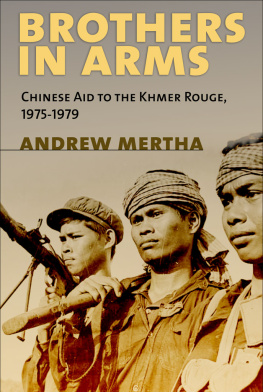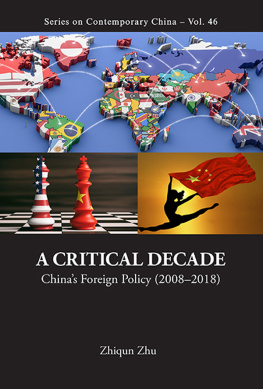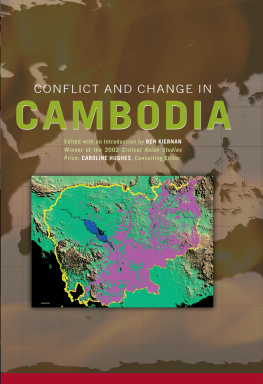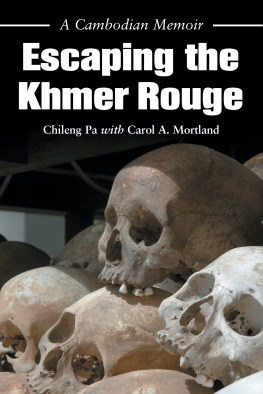Acknowledgments
The idea for this book began in March 2010, when an old Cambodia hand, Henri Locard, took me and a few others on a day trip to the Krang Leav airfield, an airport built by Cambodian slave labor under the political authority of the Khmer Rouge but under the management of Chinese technical advisers. We surveyed the airfield and the surrounding infrastructure, taking care to avoid unexploded ordnance, even descending into what initially looked like a cave but was in fact an unfinished underground command center that evoked images of SPECTRE and NORAD. Between avoiding snakes and side-stepping the layers of bat guano in the airless and sticky heat, I could not help ruminating over some fundamental questions: How is it that so few people know about this place? If we know so know little about this airfield and Chinas involvement with it, what else do we not know about what happened during the Khmer Rouge era in Cambodia? Such questions inspired the research that culminated in this book.
When I began, I had the unenviable task of starting at the very bottom of the food chain in what was for me a new area of scholarship: I had no contacts, minimal language skills, and what can only be described as an impressive reservoir of sheer ignorance. In short, I felt like a first-semester graduate student again. And that was just on the Cambodia side. In China, I had to learn a new set of institutions, some of which have not existed for decades, involving a subject that officially did not exist. So it goes without saying that I benefited greatly from the generosity of others.
The staff at National Archives of Cambodia was unflinchingly and unfailingly helpful in providing key documents and data and also worked tirelessly to make sure that I could compile them in a timely fashion. Yi Dari, in particular, deserves special thanks. Youk Chhang and the Documentation Center of Cambodia (DC-CAM) were very generous in providing documents for an earlier project, which also proved to be very helpful for this one. Finally, a great number of Cambodia specialists were disarmingly supportive and helped me at each stage. This project would have been inconceivable without them. Special thanks go to David Chandler, Craig Etcheson, Steve Heder, and Henri Locard. Others for whom I express my gratitude include John Ciorciari, Lois De Menil, Nic Dunlop, Penny Edwards, Anne Hansen, Ben Kiernan, Judy Ledgerwood, Davin Lim, Vera Manuello, Philip Short, Laura Summers, Nate Thayer, and Benny Widyono. My research assistant in Cambodia, the promising young scholar Keo Duong, tirelessly enabled me to locate and interview former (and necessarily anonymous) Khmer Rouge officials whom I never would have been able to find, let alone approach, on my own.
In China, I am indebted to another set of anonymous sources who had served as technical advisers in Democratic Kampuchea. They graciously offered their time and shared their recollections, photographs, diaries, and other materials that allowed me to breathe life into the inanimate blueprints, shipping schedules, telegrams, bills of lading, and other documents I had culled from the Cambodian National Archives. These interviewees are extraordinary people who lived through some of the most difficult challenges Maoist China could throw at them, emerging with their intelligence, dignity, and subversive sense of humor intact. They are some of the most impressive people I have ever met throughout my professional career. In thinking about the China side of the equation, I am grateful to the comments and support of Kjeld Erik Brdsgaard, Nis Grnberg, Kevin OBrien, Michael Szony, and Ezra Vogel. In China and Cambodia and Hong Kong I was able to succeed only through the prodigious talent, stamina, and exquisite good nature of my superb research assistant, Emily Cheung.
At Cornell, I have many people to thank as well. Sid Tarrow inspired me to think outside of China, urging me to become a real comparativist. He suggested fascist Italy; I chose communist Cambodia. I remain ever grateful. Peter Katzenstein compelled me to think about the normative dimensions of what I was doing; he also deserves my thanks. Allen Carlson helped ensure that I did not embarrass myself too much as I ventured into the subfield of international relations. Matt Evangelista, Jonathan Kirshner, and Tom Pepinsky may be surprised to learn that they helped me a great deal in navigating some of the questions that arose along the way, helping to transform what was rapidly turning into a historical monograph into what I hope to be a work of political science. Val Bunce helped me think long and hard about the vast differences between socialist regimes, despite their more apparent yet superficial similarities. Thak Chaloemtiarana and Tamara Loos recruited me into Cornells Southeast Asia Program, which served as a launching pad into a brand-new scholarly world. Lorraine Paterson showed me how to straddle the moving parts that connect and separate China and Cambodia. Ding Xiang Warner, then the director of the East Asia Program, offered financial and moral support. Ken Roberts and the Institute for Social Sciences also generously provided funds for research assistance, as did Xu Xin at the China and Asia Pacific Studies (CAPS) program. This money was well spent on yet another set of terrific research assistants at Cornell, Wendy Leutert and Lin Fu. My infinitely patient Khmer language teacher at Cornell, Hannah Phan, remains my linguistic lifeline to the soul of Cambodia. She also helped me with the transliteration of a number of Khmer words and phrases to achieve some measure of consistency. Fellow intrepid traveler John Kandels enthusiasm at the Krang Leav site helped me realize that I might be onto something.
I thank my high school art history teacher, Ruth Chapman, who enthusiastically indulged and supported my fascination with all things Cambodian when I was sixteen. In many ways this book is a tribute to her. Thank you, Ruth.
I am grateful once again to Roger Haydon and the entire team at Cornell University Press for shepherding this project through the publication process without mincing words, as well as to the two reviewers whose comments allowed me to transform a draft manuscript into a much better book.
Despite all the aforementioned help, and even with my best efforts, mistakes inevitably remain. The responsibility for them is mine alone.
My family gave me the time and space necessary to work on this project, supporting me throughout. My inestimably wonderful wife, Isabelle, among a million other things helped me reestablish my priorities; horrified by an impromptu Adirondack cliff dive in the summer of 2011, she told me that such acts of idiocy do not impress her writing books does. Et viol! But the person who has sacrificed the most is my daughter, Sophie Ruobin Mertha, who can at long last look forward to spending some quality time with the old man. She is an inspiration to me, every day and in every way. I dedicate this book, with all my love, to her.
A Note on Transliteration
I employ the pinyin form of Romanization used in the Peoples Republic of China except in cases of direct quotes or references that use other forms of Romanization, most prominently Wade-Giles, such as in the case of the Chinese shipping vessel Yong Kang .
Because Khmer does not yet have a standard Romanized form, I have been forced to make a number of suboptimal editorial decisions. In keeping with the current standard, I have kept widely accepted transliterations of relatively well-known personal and place names. Where transliterated Khmer words are quoted from primary and secondary sources, I have generally kept these as well. When citations use a particular Romanization of Khmer as part of the citation title, I retain the original to avoid confusion. Some proper nouns have more than one common transliteration. For the key term, Angkar (Organization), I use the r at the end of the word. Vorn Vet is also referred to as Vorn Veth; in this book, I use the former. Van Rith is also referred to as Van Rit; I similarly employ the former transliteration. Ke Pauk is sometimes referred to as Ke Pork; I use Ke Pauk. In the case of Eastern Zone Commander So Phim, there are two common transliterations that conform to the two common Khmer spellings of his name, both of which are in the glossary; I use So Phim. I provide the Khmer script in the glossary for most of the Khmer terms I use in the book.








